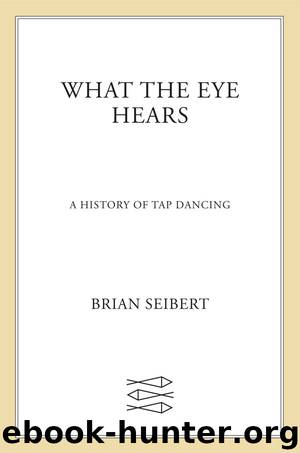What the Eye Hears: A History of Tap Dancing by Brian Seibert

Author:Brian Seibert [Seibert, Brian]
Language: eng
Format: mobi
ISBN: 9781429947619
Publisher: Farrar, Straus and Giroux
Published: 2015-11-17T05:00:00+00:00
TAPPING BIRD
Edwin Denby caught it in in 1942, at a “coffee concert” at the Museum of Modern Art: “a man who did a tap dance as purely acoustic as a drum solo.” It was interesting, Denby noted, how the man “ignored the ‘elegant’ style in shoulders and hips, sacrificing this Broadway convention to the sound he made.” The man was called Baby, and he wasn’t accustomed to giving concerts at museums. But the sound he made was modern art, modern jazz.
Born in Baltimore in 1921, Laurence Donald Jackson was on the road with Don Redman’s band by age eleven, as a singer. His parents died soon after, in a fire, and instead of living with an aunt, he ran away to New York. Dickie Wells, who had parlayed his membership in the early class act Wells, Mordecai, and Taylor into ownership of a Harlem nightclub, unofficially adopted the young singer and gave him his stage name, Baby Laurence. The kid sang with the Four Buds, who joined with the Three Gobs to become the Six Merry Scotchmen or the Harlem Highlanders, an act that wore kilts to voice Jimmie Lunceford arrangements in six-part harmony. At the same time, Laurence was hanging out at the Hoofers’ Club, learning to dance. Robinson and Bubbles weren’t much help, but Eddie Rector was, along with young guys such as Raymond Winfield and Honi Coles, and an otherwise unknown member of the Three Playboys named Harold Mablin. When Laurence executed a step differently from how Mablin had demonstrated it, Mablin would get mad. All Laurence could say was, “I just don’t feel it that way.” At the Hoofers’ Club, that was all he had to say.
One reason Laurence felt steps differently was that he was listening to different music. In the mid-thirties, he sang at the Onyx Club on Fifty-second Street, where Art Tatum made his New York debut. Tatum was the piano player other piano players called God. His technique was orchestral, bewilderingly rapid and dexterous at the service of a bewilderingly quick and inventive mind and ear. His music ran in cascades and cataracts, in and out of tempo, in flights and adventures of harmony and time. When Laurence heard Tatum play, he felt the urge to move his feet in emulation of Tatum’s fingers. A boy could dream. Around 1940, with the assistance of Leonard Reed, Laurence put together a solo tap act, and soon he was slotted into touring revues with the bands of Count Basie and Duke Ellington. The Basie band had the most solid and swinging rhythm section in jazz, support so trustworthy it inspired bold departures. The band’s drummer, Jo Jones, was a selfless accompanist, gently assenting and escorting. At one time a tap dancer himself on the carnival circuit, he understood what a tap dancer needed, how to stay out of a hoofer’s way and “catch” him with complementary fills and cymbal crashes. (Decades later, he would release a pedagogical album with sample rhythms by Bill Robinson, Eddie Rector, Pete Nugent—and Baby Laurence.
Download
This site does not store any files on its server. We only index and link to content provided by other sites. Please contact the content providers to delete copyright contents if any and email us, we'll remove relevant links or contents immediately.
| Anthropology | Archaeology |
| Philosophy | Politics & Government |
| Social Sciences | Sociology |
| Women's Studies |
Cecilia; Or, Memoirs of an Heiress — Volume 1 by Fanny Burney(32436)
Cecilia; Or, Memoirs of an Heiress — Volume 2 by Fanny Burney(31872)
Cecilia; Or, Memoirs of an Heiress — Volume 3 by Fanny Burney(31857)
The Great Music City by Andrea Baker(31372)
We're Going to Need More Wine by Gabrielle Union(18970)
All the Missing Girls by Megan Miranda(15583)
Pimp by Iceberg Slim(14397)
Bombshells: Glamour Girls of a Lifetime by Sullivan Steve(13977)
Talking to Strangers by Malcolm Gladwell(13225)
Norse Mythology by Gaiman Neil(13210)
Fifty Shades Freed by E L James(13158)
For the Love of Europe by Rick Steves(13037)
Mindhunter: Inside the FBI's Elite Serial Crime Unit by John E. Douglas & Mark Olshaker(9206)
Crazy Rich Asians by Kevin Kwan(9170)
The Lost Art of Listening by Michael P. Nichols(7409)
Enlightenment Now: The Case for Reason, Science, Humanism, and Progress by Steven Pinker(7238)
The Four Agreements by Don Miguel Ruiz(6636)
Bad Blood by John Carreyrou(6554)
Weapons of Math Destruction by Cathy O'Neil(6148)
